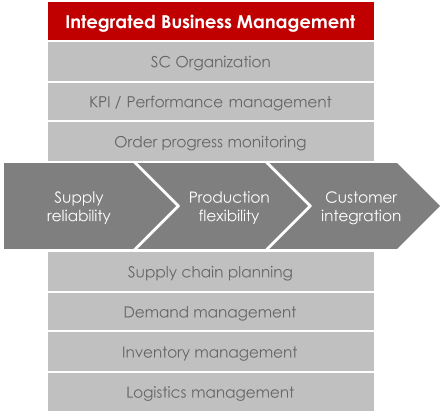

- Value Chain Excellence
- Company Business Performance
- Supply Chain Performance
- Supply Chain Strategy
- Integrated business management (S&OP)
- Digital Transformation
- Operational Improvement
- Transparency
- Complexity
- Agility
- Responsiveness
- Customer Needs
- Delivery Reliability
- SC Segmentation
- Inventory optimization
- Throughput Times
- Order Management
- Planning Excellence
- Cost management
- Logistics Cost
- Working Capital Optimization
- Supplier Optimization
- Transport Optimization
- Network Optimization
- Post Merger Integration
INTEGRATED BUSINESS MANAGEMENT
Integration of Demand and Supply possibilities in the Sales,
Inventory, Operations Planning leads to success in overall
business management
•
The methods developed in Sales and Operations Planning
(S&OP) are well known, and well proven in the general field of
supply chain management. Yet, many companies still struggle
to really see, understand, and benefit from the full impact of
this typically monthly alignment process to gear the supply
chain to superb performance, meeting the always changing
market needs.
•
The first challenge is to establish the process as such, to get all
relevant paricipants as delegates of their functions, to
participate in a regular, and prepared way. To take it serious,
see the value, and have them engaged and motivated.
•
Second challenge is to have the right set of information, so that
the participants have compatible data, and do not surprise
each other by presenting some information out of a “magic
source”. Many companies have mastered this challenge by all
participants working real-time in the same data environment.
•
Third challenge is to find the right mode for making decisions.
This involves clarity for decision processes within the meeting,
and also regulations and definitions for decisions which need a
different setting to come to the right decision. In this context, a
good scheme of escalation procedures is vital to keep the
process, and its results, on track.
•
Another challenge is to find the right frequency, the right
regional and organizational scope, and the suitable reach of
the time horizons. Although monthly cycles and 12 months of
reach are most common (some use 2, others 3 months cycles),
it needs to fit to the needs of the business. And linking local,
regional, and global operations also requires a specific solution
to bring the intended value for the business.
•
And, finally on the “top-item-list”, general management needs
to agree to the scenarios presented, the insights and findings,
and also support the results, and decisions made. Ideally, top
management sees this process as a means to reduce the many
firefighting meetings happening manifold, and also replaces
many of the “regular reporting meetings”. And on this basis
manages the whole value chain, and the company, on the
back of this highly vital process.
•
From an IT enabler perspective, there is nowadays a high
number of solutions available, each with specific strenghts, and
application advantages. It is also not only about the numbers,
but increasingly about the communication to come to the
numbers and insights. Therefore advanced tools also include
elements of social media to replace cumbersome E-Mail-
Communication with embedded (and conserved) on-line
communication possibiliites.
















